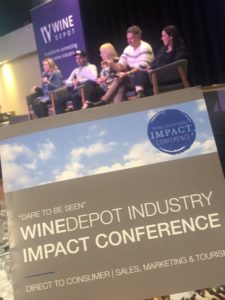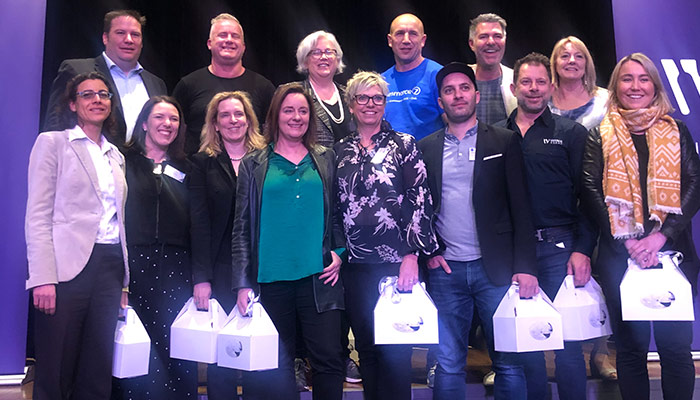The Australian wine industry gathered in Orange in September 2019 for the Wine Depot Industry Impact Conference, facilitated by WISA.
With the theme of “Dare to be Seen” it was a great opportunity to revisit best practices and focus on consumer experiences, insights and analysis in the world of direct wine marketing and sales.
The first day saw eight sessions with presentations ranging from key online shopping trends to a case study of the Brokenwood “winery hospitality venue” in the Hunter Valley, which opened after massive renovations in late 2018. Day two was workshop centric, with sessions covering a range of topics including social media, storytelling and more involved use of platforms. A heartfelt conclusion from Nick Bowdich closed a thought provoking two days.
What are the key insights and trends to be aware of?
 The Wine DTC Opportunity
The Wine DTC Opportunity
Sandy Hathaway from Wine Australia revealed the performance of Direct-to-Consumer (DTC) for wineries across Australia from the latest Wine Australia survey. A great tool to be used by industry, which will be made more robust in future by more participants getting involved to deepen the data set. According to the picture painted by these figures, “Cellar door is at the heart of DTC”, and “DTC upside is HUGE but not being realised.”
A challenge for staff in the cellar doors across Australia is to increase wine club conversions, recognising the potential revenue this loyal group of customers add. There are on average, 572 new sign ups to wine clubs per winery per year (around 3% conversion). What does this tell us? There is immense opportunity to convert the 17,600 (on average) cellar door visitors per winery in the past 12 months to loyal wine club members.
When and where are consumers buying online?
People are shopping later in the day with over 32% of transactions made from 7 – 10pm. The laptop is still the most common device but it has declined in popularity. Mobile transactions have grown by 28.8% year on year.
There are a few easy ways to leverage these insights:
- Time your email communications to take advantage of this shopping behaviour
- Ensure you have a mobile optimised website

Figure 1- When are consumers buying online. Source: Inside Australian Online Shopping 2019, Australia Post
Top 10 postcodes for wine and liquor online sales
Specific to wine and liquor online sales, there has been a national average growth of 8.1% year on year (YOY)[1]. The top 10 postcodes for online wine & liquor sales for the past year is shown below.
| Rank | Postcode | Suburb | Growth |
| 1 | 2088 | Mosman | 3.2% |
| 2 | 2065 | St Leonards | -1.6% |
| 3 | 2010 | Surry Hills | -0.7% |
| 4 | 2250 | Gosford | 1.5% |
| 5 | 3186 | Brighton | 9.1% |
| 6 | 2066 | Lane Cove | 3.5% |
| 7 | 7250 | Launceston | 16.1% |
| 8 | 4069 | Kenmore | 3.4% |
| 9 | 3121 | Richmond | -0.1% |
| 10 | 2060 | North Sydney | -0.2% |
It’s time timing of the delivery that’s becoming paramount. The Australia Post report shows:
“online shoppers increasingly expect faster service and some savvy retailers are now offering quicker fulfilment and shipment. This competitive edge potentially helps retailers stand out and convert more sales. Next day deliveries have grown by 31.7% and more than 62% of these are fashion related.”
These insights tied in perfectly with the new wine fulfillment service Wine Depot which is set to turn delivery on it’s head and provide wineries with more options to reach consumers in a fast and efficient way.
Becoming famous
Love to tell your brand story outside your cellar door and events? Felicity Carter the editor of German-based global wine magazine Meininger’s Wine Business had some great ideas for making your brand stand out in the crowd. She later sat on the panel session and condemned the latest fad of ‘influencer’ marketing and encouraged wine brand owners to think about telling their stories.
Felicity left the audience with some truths and some tips and tricks for making media work for your wine brand:
- To be globally famous, you need to be famous in your own area.
- If you are compelled to call someone you know about something that has happened then “it is probably newsworthy”
- Target print publication with an online presence: news aggregators such as Daily Wine News or Drinks Business in UK are the kind of sites which aggregate content so the story is more likely to spread and give additional reach.
- Photography is so important. Get professional headshots and product shots done and continue to invest in your brand imagery.
- Name your photos with your brand name so they can be easily found by journalists and crawled by Google – not DSC_1777 – be specific about what the photo is of
- For print media, send portrait orientation, but for online media send square or horizontally cropped photos
- Everything must be optimised for Google search
- The only content worth creating is either shareable or useful
- First time since the Greco-Roman era we are going back to an oral culture. Speaking clearly is of huge and growing importance. People need to be able to pronounce the label, the inability to do this makes a major barrier if your label or name is very hard to pronounce.
- Love NOT passion (passion is overused). We love people who love something.
- Don’t talk about soil! (unless you can explain to the consumer “Why” it matters to them)
- There is one story you MUST tell. You MUST talk about sustainability initiatives. Whatever you can do to reduce chemical, water, energy inputs. Whatever you are already doing, talk about it!
A number of other speakers talked about the importance of images and professional photography in reaching your sales and marketing goals for DTC. The importance of video in storytelling is also growing through Youtube, Facebook and IGTV. Shareable and useful content works.
Are you in the wine or tourism business?
The case study of the Brokenwood Wines relaunch was presented by General Manager, Geoff Krieger. He spoke first of their insight that they are actually not in the wine business, but in the tourism and hospitality industry. Indeed, Brokenwood were the first to charge for the tastings in Hunter Valley in 2014 at $5 per tasting.
The impetus to build their new, architecturally impressive winery hospitality venue was to prioritise their DTC business and sell experiences. This reduces their reliance on the supermarket chains who were demanding and not treating the brand well through discounting and deals.
What was their objective? To host many more people and allow them to stay longer, for one reason: to sell more wine.
This is how they did it:
- Tourism SKUs were created to go beyond wine products
- 47 wine SKUs
- Corporate offerings for weeknight evenings
- Cashless cellar door
- Triage at the start of the visit to collect email, credit card and phone number
- Booking system on the website, made very visible on the home page
- Tasting fees are split into levels: the $10 tasting is redeemable on purchase but the $25 Single Vineyard Club tasting is redeemable as store credit at cellar door or at the onsite restaurant to encourage more time in venue.
With two dining options, a takeaway and private members areas for events and tastings, the new cellar door is a venue that invites people to not only taste, but to eat, relax and talk. They have tasting ‘pods’ rather than one long tasting bench to encourage smaller groups and less wait time during busy periods.
Leveraging TripAdvisor
Melissa Laurie from TripAdvisor explained the trends in the modern traveller. She said, “travellers love to share” and her advice is to “Respond to reviews! If people have taken the time to leave a review about your business, it opens up a potential channel for communication.”
At the cellar door you may like to do some primary research by asking the following questions:
- How have people found you?
- What has sparked their interest to be in your place today?
Then keep an eye on what is trending on the web. Keep website content relevant to google search and the keywords that relate to your target travellers. TripAdvisor is showing a 204% growth in the family-friendly search for travel options.
What are some other tips?
- Ensure your basic listings need are right. Make sure the details on your Google Listing and trip Advisor listing are correct. This includes contact details, opening hours and address/map information
- On the TripAdvisor app you get translated to 28 languages, people interested in your venue or product are travellers, so ensure your website is optimised for mobile
The role of influencer marketing
Our own Trish Barry joined Fabien Laine, Drew Lambert of Wine Wankers and Felicity Carter in a robust panel discussion about the role of influencer marketing in the wine industry.
Some of the advice from the panel about getting into this space included:
- Be careful about the belief that influencers are a trusted source of information about brands. 70% of vinepair.com readers say they trust the opinion of their friends over wine professionals
- Build trust with your members and those who have visited you at your “place”. Fabien strongly believes that your best influencer is the person who comes to visit you in your cellar door and has made an investment of their time at your place
- Be strategic – engage people who are relevant to your audience and core demographic
- Use social media tools to find the people who are your super fans and engage regularly to grow the tribe
- Engage with everyone who comments on one of your posts
- Support your other wineries in your region and comment / share their posts
Most importantly recognise that influencer marketing is evolving and needs to be considered as part of your marketing mix. It’s not going away but you need to properly evaluate who you work with to make sure it’s a right fit for your brand.
A lesson in craft marketing from gin producer, Four Pillars
Matt Jones from Four Pillars was the final speaker for the first day and he gave a masterclass on brand values and marketing in the world of craft gin. Four Pillars is Australia’s fastest growing and most popular craft spirit maker.
Matt introduced the crowd to the concept of the “peacock brand”, the one which is worth seeking out. His advice is to be a brand that is worth seeking out because of the commitment you have made to your craft (and then be easy to transact with).
Marketing is the whole experience. In the current environment, “good enough is not good enough”.
Some of Matt’s hot tips include:
- What does success look like so you can energise the team around it?
- Commit to a few things that are meaningful to reaching your success
- Give it time to work
He also prompts you to answer these four questions about your brand:
- Purpose: why would they miss you if you closed down?
- Craft: what right do you have to be in that role?
- Experience: are these being echoed and amplified in your experiences?
- Community: who are you talking to and working with?
Selling online with Commerce7
Andrew Kamphius, the CEO of Canadian-based ecommerce solution Commerce7 talked about getting the simple things right online. Ensure you make it easy for consumers to buy from you.
Commerce7 has many great features and will integrate with existing WordPress websites, as well as integration with MailChimp and other compatible software such as Vintrace and Xero.
Commerce7 are data-driven and whilst there are many metrics Kamphuis can report on for his clients, he spoke of only one in detail, the Net Promoter Score.
In the USA and Canada, consumers are often asked to rate their experience post-purchase via a survey. The most telling of these survey results, according to Kamphuis is the Net promoter score. Andrew says:
“We know that the customer experience matters more than ever, more than our product, more than price. Having a great customer experience will bring them back to your cellar door and website over and over.”
A customer who has a great experience and rates you a 9 or 10 will come back to your website and buy from you again and better still, becomes a ‘promoter’. The cost of acquiring a customer or visitor to you site is higher than retaining an existing customer and word-of-mouth referrals are significant drivers of wine consumer behaviour. It makes sense that your own website (which you can control) is a true representation of your brand and easy for consumers to navigate and transact.
As a side note, Mastermind Consulting has built the first Australian Commerce7 website with the recent launch of Swinging Bridge’s new website and are strong advocates of the potential that this integrated platform can offer. If you have any questions or want to know more, we are always happy to hear from you.
Measure and focus on the right measurements
“People respect what you inspect” was the mantra of WISE (Wine Industry Sales Education) Academy CEO, Lesley Burglund.
We are swamped with so much data in our modern business world and a winery is no different. But what is the right data to collect and what metrics make the most difference in a winery’s profitability?
“Information from our business activities has gone from scarce to super abundant. Our goal is to turn this data into information and the information into insights and action.”
Lesley offered a template for increasing the profitability of (mainly US-based) wineries by concentrating on some very specific direct-to-consumer measurements.
Collecting and reporting on hard internal data such as sales, number of tastings, visitors to online shop and email conversions is a start – that way you can look at trends and compare this year to last year.
The second set of data to look at is benchmarks for your industry (see the report by Sandy Hathaway from Wine Australia). Finally, look at the soft data metrics such as customer satisfaction and loyalty.
Lesley encouraged winery owners to be regularly inspecting these metrics and pushed those with staff to create a DTC dashboard with the metrics (and performance) clearly visible to all cellar door and direct-to-consumer staff.
Setting goals and KPIs to build average order value and grow the conversion rate from Cellar Door visitors to Wine Club members is vital as these are two very important ways to increase the overall profitability of your wine business.
“Does your team know what the score is?” she ended. “Unless they really understand how to keep score, they don’t know if they’re winning or losing on a daily basis.”
A new approach for social media marketing
Trish Barry headed up a workshop session on the next evolution of social media, highlighting how the big social media platforms are evolving to a more private one on one relationship. She highlighted six elements to refocus on for social media success in 2020
-
-
- Be social
- Quality content
- Get your consumers involved!
- Pay to play
- Test and trial new things
- Build a strong digital home base
-
Four ways to increase your winery’s profits
The clear message at the WineDepot Impact Conference is that there is a huge opportunity for Australian and New Zealand wine brands to sell more wine, more profitably by pivoting toward direct-to-consumer sales. In summary, the four key ways to do this successfully are:
-
-
- Understand the right data metrics and measure often
- Build a profitable wine club
- Get consumers to be your advertisers
- Offer a great experience – cellar door and especially online. Think beyond selling wine and think about the hospitality offering
-
This message resonates strongly with the Mastermind team given our focus on wine direct-to-consumer strategies. We’ve successfully implemented direct-to-consumer growth plans for over 15 years and would love to chat about how we can help share some insights to help grow sales for your brand.
[1] Australia Post – Inside Australian Online Shopping 2019









